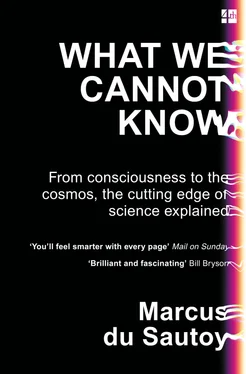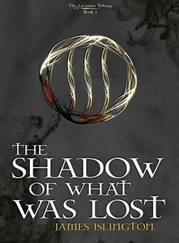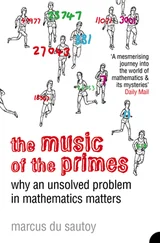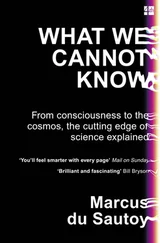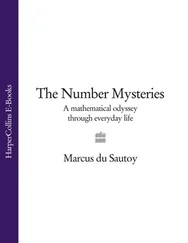But it’s not only the mathematics of probability that is at work in evolution. The evolutionary tree itself has an interesting quality that is similar to the shapes that appear in chaos theory, a quality known as fractal.

The fractal evolutionary tree.
The evolutionary tree is a picture of the evolution of life on Earth. Making your way through the tree corresponds to a movement through time. Each time the tree branches, this represents the evolution of a new species. If a branch terminates, this means the extinction of that species. The nature of the tree is such that the overall shape seems to be repeated on smaller and smaller scales. This is the characteristic feature of a shape mathematicians call a fractal. If you zoom in on a small part of the tree it looks remarkably like the large-scale structure of the tree. This self-similarity means that it is very difficult to tell at what scale we are looking at the tree. This is the classic characteristic of a fractal.
Fractals are generally the geometric signature of a chaotic system, so it is suggestive of chaotic dynamics at work in evolution: the small changes in the genetic code that can result in huge changes in the outcome of evolution. This model isn’t necessarily a challenge to the idea of convergence, as there can still be points in chaotic systems towards which the model tends to evolve. Such points are called attractors. But it certainly questions whether if you reran evolution it would look anything like what we’ve got on Earth today. The evolutionary biologist Stephen Jay Gould has contended that if you were to rerun the tape of life that you would get very different results. This is what you would expect from a chaotic system. Just as with the weather, very small changes in the initial conditions can result in a dramatically different outcome.
Gould also introduced the idea of punctuated equilibria, which captures the fact that species seem to remain stable for long periods and then undergo what appears to be quite rapid evolutionary change. This has also been shown to be a feature of chaotic systems. The implications of chaos at work in evolution are that many of the questions of evolutionary biology could well fall under the umbrella of things we cannot know because of their connections to the mathematics of chaos.
For example, will we ever know whether humans were destined to evolve from the current model of evolution? An analysis of DNA in different animals has given us exceptional insights into the way animals have evolved in the past. The fossil record, although incomplete in places, has also given us a way to know our origins. But given the time scales involved in evolution it is impossible to experiment and rerun the tape of life evolving on Earth and see if something different could have happened. As soon as we find life on other planets (if we do), this will give us new sample sets to analyse. But until then all is not lost. Just as the MET office doesn’t have to run real weather to make predictions, computer models can illustrate different possible outcomes of the mechanism of evolution, speeding up time. But the model will only be as good as the hypotheses we have made on the model. If we’ve got the model wrong, it won’t tell us what is really happening in nature.
It’s such computer models that are at the heart of trying to answer the question Poincaré first tackled when he discovered chaos: will there even be a stable Earth orbiting the Sun for evolution to continue playing its game of dice? How safe is our planet from the vagaries of chaos? Is our solar system stable and periodic, or do I have to worry about a grasshopper disrupting our orbit around the Sun?
A BUTTERFLY CALLED MERCURY
Poincaré wasn’t able to answer the King of Sweden’s question about the solar system: whether it would remain in a stable equilibrium or might fly apart in a catastrophic exhibition of chaotic motion. His discovery that some dynamical systems can be sensitive to small changes in data opened up the possibility that we may never know the precise fate of the solar system much in advance of any potentially devastating scenario unfolding.
It is possible that, like population dynamics with a low reproductive rate, the solar system is in a safe predictable region of activity. Unfortunately, the evidence suggests that we can’t console ourselves with this comforting mathematical hope. Recent computer modelling has provided new insights which reveal that the solar system is indeed within a region dominated by the mathematics of chaos.
I can measure how big an effect a small change will have on the outcome using something called the Lyapunov exponent. For example, in the case of billiards played on differently shaped tables, I can give a measure of how catastrophic a small change will be on the evolution of a ball’s trajectory. If the Lyapunov exponent of a system is positive, it means that if I make a small change in the initial conditions then the distance between the paths diverges exponentially. This can be used as a definition of chaos.
With this measure several groups of scientists have confirmed that our solar system is indeed chaotic. They have calculated that the distance between two initially close orbital solutions increases by a factor of ten every 10 million years. This is certainly on a different timescale to our inability to predict the weather. Nevertheless, it means that I can have no definite knowledge of what will happen to the solar system over the next 5 billion years.
If you’re wondering in despair whether we can know anything about the future, then take heart in the fact that mathematics isn’t completely hopeless at making predictions. There is an event that the equations guarantee will occur if we make it to 5 billion years from now, but it’s not good news: the mathematics implies that at this point the Sun will run out of fuel and evolve into a red giant engulfing planet Earth and the other planets in our solar system in the process. But until this solar blowout engulfs the solar system, I am faced with trying to solve chaotic equations if I want to know which planets will still be around to see that red giant.
This means that, like the predictions of the weather, if I want to know what is going to happen, I am reduced to running simulations in which I vary the precise locations and speeds of the planets. The forecast is in some cases rather frightening. In 2009 French astronomers Jacques Laskar and Mickael Gastineau ran several thousand models of the future evolution of our solar system. And their experiments have identified a potential butterfly: Mercury.
The simulations start by feeding in the records we have of the positions and velocities of the planets to date. But it is difficult to know these with 100% accuracy. So each time they run the simulation they make small changes to the data. Because of the effects of chaos theory, just a small change could result in a large deviation in the outcomes.
For example, astronomers know the dimensions of the ellipse of Mercury’s orbit to an accuracy of several metres. Laskar and Gastineau ran 2501 simulations where they varied these dimensions over a range of less than a centimetre. Even this small perturbation resulted in startlingly different outcomes for our solar system.
You might expect that if the solar system was going to be ripped apart it would have to be one of the big planets like Jupiter or Saturn that would be the culprit. But the orbits of the gas giants are extremely stable. It’s the rocky terrestrial planets that are the troublemakers. In 1% of simulations that they ran, it was tiny Mercury that posed the biggest risk. The models show that Mercury’s orbit could start to extend due to a certain resonance with Jupiter, with the possibility that Mercury could collide with its closest neighbour, Venus. In one simulation, a close miss was enough to throw Venus out of kilter, with the result that Venus collides with Earth. Even close encounters with the other planets would be enough to cause such tidal disruption that the effect would be disastrous for life on our planet.
Читать дальше
